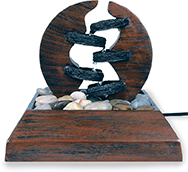Quick Lab
Modeling Resistance in a Wire
Materials
white paper, metric ruler, number 2 pencil, multimeter
Procedure
Draw a narrow rectangle 1 cm wide by 5 cm long on the paper. Draw a wide rectangle, 3 cm by 5 cm. Use the pencil to completely fill in both rectangles with graphite.
Place the multimeter electrodes at opposite ends of the narrow rectangle. Record the resistance. Keep one electrode in place and slowly drag the other one toward it. Record your observations.
Repeat Step 2 using the wide rectangle.
Analyze and Conclude
Observing In which rectangle is the resistance greater? How does resistance change as the electrodes move together?
Using Models Explain why a thick wire has lower resistance than a thin wire if all else is equal. Why does resistance decrease as a wire's length decreases?
Voltage
If you remove the batteries from a flashlight, the light will not shine. Why? Because there is resistance in the wires and the bulb, charges do not flow on their own without a source of energy.  In order for charge to flow in a conducting wire, the wire must be connected in a complete loop that includes a source of electrical energy.
In order for charge to flow in a conducting wire, the wire must be connected in a complete loop that includes a source of electrical energy.
Figure 9 A water fountain has a pump inside that lifts water to the top, increasing the gravitational potential energy of the water. In the same way, a voltage source increases the electrical potential energy of electric charges.

Potential Difference
Recall that potential energy is related to position. In Figure 9, water at the top of the fountain has more gravitational potential energy than water at the bottom. That is why water falls spontaneously from a higher to a lower height. In the same way, charges flow spontaneously from a higher to a lower potential energy.
The potential energy of a charge depends on its position in an electric field. Potential difference is the difference in electrical potential energy between two places in an electric field. Potential difference is measured in joules per coulomb, or volts. Because it is measured in volts, potential difference is also called voltage.
Voltage Sources
How does water get to the top of the fountain? A pump inside the fountain does work on the water to increase its potential energy. In the same way, a source of voltage such as a battery does work to increase the potential energy of electric charges.
Three common voltage sources are batteries, solar cells, and generators. A battery is a device that converts chemical energy to electrical energy. Batteries, like other voltage sources, have terminals that can connect to wires in a circuit. One terminal is positive and the other is negative. A voltage drop, or potential difference, is maintained across the terminals. In a 9-volt battery, for example, the voltage drop is about 9 volts.




